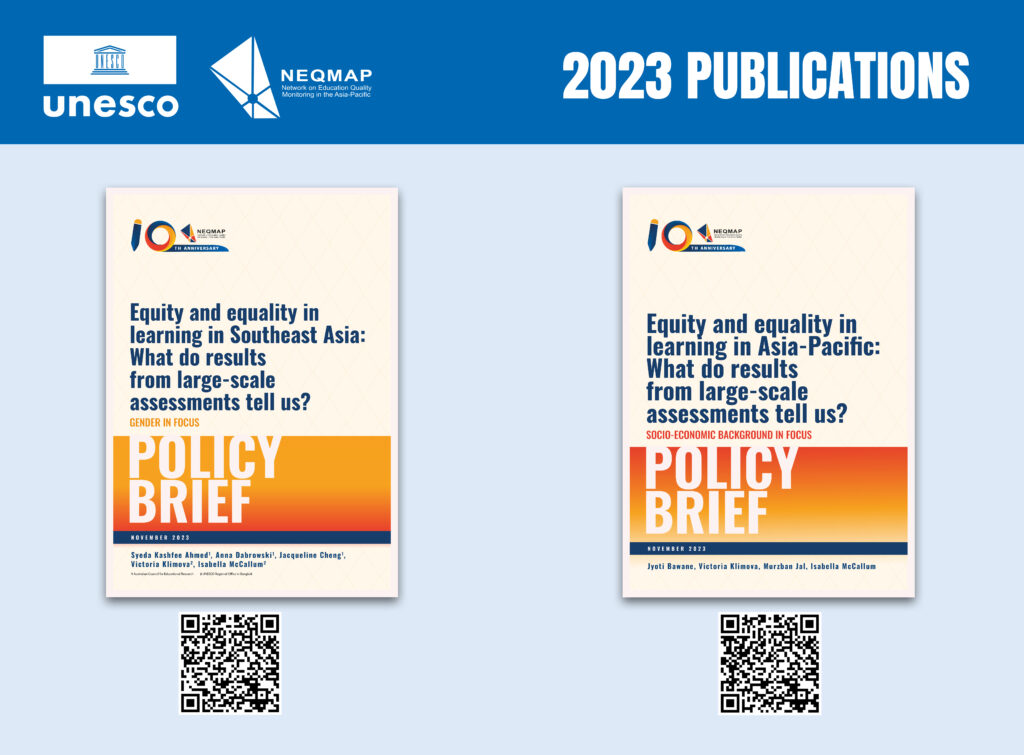The Network on Education Quality Monitoring in the Asia-Pacific (NEQMAP) and UNESCO Bangkok have launched a series of policy briefs on “Equity and Equality in learning in Asia-Pacific: What do results from large-scale assessments tell us?” The first two policy briefs were created in partnership with the Australian Council for Educational Research and the Indian Institute of Education and cover such thematic areas as gender and socio-economic background, respectively. The series will continue in 2024, focusing on ethnolinguistic minorities and rural and urban differences in learning outcomes.
The policy briefs identified differences in learning environments and factors that underpin gender and socio-economic gaps and emphasized promising policies and practices to mitigate the disparities in academic achievement from across Asia-Pacific that help reduce inequity and ensure better learning for all. The reports rely on the rich, large-scale assessment (LSA) datasets in the region, including international and regional data (PISA, TIMSS, SEA-PLM etc.) as the primary source of learning outcomes.
Key findings
Equity and equality in learning in Asia-Pacific: Socio-economic background in focus
- The Asia-Pacific region has the largest share of top performers and low achievers globally. Evidence indicates that socio-economic status strongly predicts academic achievement in the region. In most Asia-Pacific countries, no notable shifts were detected in socio-economic disparities in learning outcomes over time.
- The prevalence of academically resilient students varies widely across countries in the region and is linked to specific student, family, and school-level factors. Analyzing resilience is crucial for policymaking as it sheds light on the effectiveness of interventions and support structures in nurturing academic success among disadvantaged students.
- The variations in school and home environments significantly impact learning outcomes. Key factors, including the availability of learning resources for students, the qualifications of teachers, and parental engagement, are crucial in shaping the educational journey of learners. These elements establish a foundational understanding of the disparities observed in learning outcomes.
- In most Asia-Pacific countries, disadvantaged students face a higher shortage of educational materials than their advantaged peers, with exceptions in Macao (China). In general, across the Asia-Pacific region, the proportion of teachers with at least a master’s degree grew with the average socio-economic profile of the schools. Higher levels of parental engagement are associated with higher reading, writing, and mathematics scores in children. While half of the children reported that their parents motivate them to succeed in school, a large proportion suggested that their parents rarely or never engage in school-related activities.
- Most Asia-Pacific countries have adopted nine years of free and compulsory primary and secondary education, which remains below the SDG 4 target of 12 years of free primary and secondary education. Only seven countries in the region have at least one year of free and compulsory pre-primary education in legal frameworks.
- Social segregation between schools will likely reinforce the link between socio- economic disadvantage and poor academic achievement. Grade repetition, a practice where students are held back for an additional year due to academic struggles, is associated with poorer academic performance, negative attitudes toward education, and a heightened risk of high school dropout. Students from low socio-economic backgrounds are more likely to repeat a grade than those from high socio-economic backgrounds.
- Policies and practices designed to mitigate or prevent socio-economic disparities at a system level:
- Close/minimize the socio-economic gap/disparities at the initial stages of education by providing at least one year of free and compulsory high-quality pre-primary education and 12 years of free and compulsory primary and secondary education.
- Offer additional support to schools with high concentrations of students from low socio-economic backgrounds.
- Promote teacher training and incentivize the most experienced teachers to work at schools with high concentrations of students from disadvantaged socio-economic backgrounds.
- Ensure integration between different socio-economic groups since children from disadvantaged backgrounds tend to do better in more socially mixed schools.
- Continue to support international, regional and national monitoring efforts.
- Policies and practices designed to mitigate or prevent socio-economic disparities at a school level:
- Implement strategies that provide practical solutions for better parental engagement with children’s learning.
- Avoid segregating students by ability, as it negatively impacts the lowest performing and often most disadvantaged children.
Equity and equality in learning in Southeast Asia: Gender in focus
- Girls tend to outperform boys in mathematics and reading across Southeast Asia. Across both PISA 2018 and SEA-PLM 2019, boys from disadvantaged socio-economic backgrounds performed the lowest of any group.
- Girls in the six participating ASEAN countries are more likely than boys to discuss learning and schoolwork with their parents. This can contribute to further improvements in their academic achievement.
- Boys overwhelmingly report higher rates of truancy and lateness. When asked about missing school, 22.9% of boys reported skipping a full day of school.
- When in the classroom, girls in the six SEA countries are more concerned about classroom quality and are more sensitive to issues such as teacher absenteeism. When asked if students had repeated grades, boys in all SEA countries were more likely to indicate that they had repeated at least one year, except for Malaysia, where grade repetition is nearly non-existent.
- Across all PISA-participating SEA countries, girls overwhelmingly agreed with statements demonstrating a positive attitude towards reading. On the other hand, boys generally agreed more to statements showing a negative attitude towards reading. An average of 58.7% of boys indicated that they “don’t read” or “read less than 30 minutes a day.
- Efforts to promote gender equity in learning in Southeast Asia require a multifaceted approach that considers the region’s diversity while addressing common challenges. Therefore, it is recommended to:
- Address sociocultural norms that limit children’s career aspirations and learning opportunities.
- Enhance teachers’ training on gender-responsive pedagogy.
- Pursue gender policy mainstreaming and gender-sensitive policymaking.
- Support evidence-based approaches to gender inclusion.






